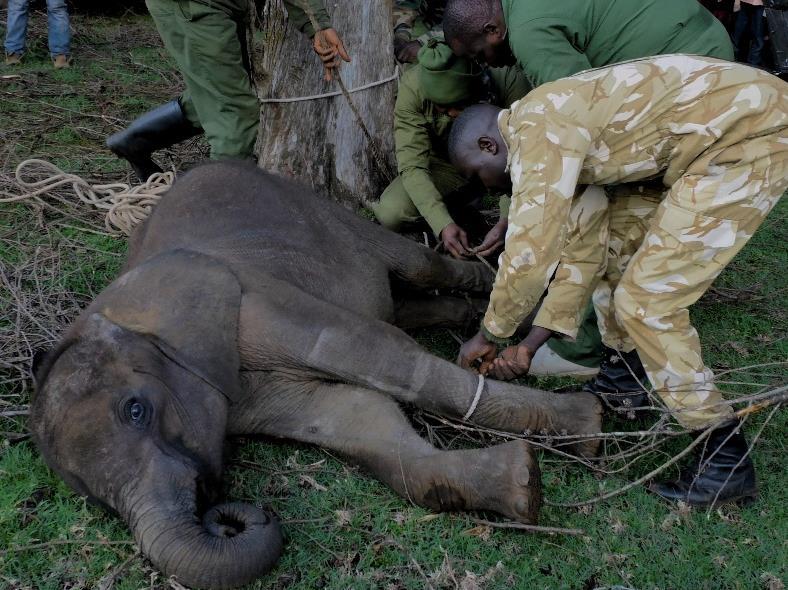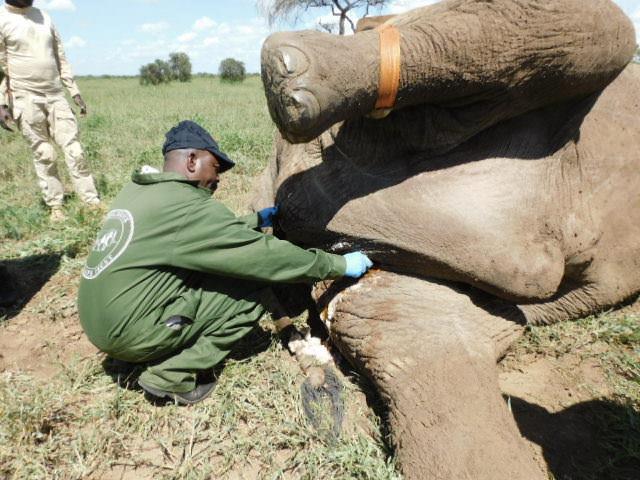
SWT/KWS SKY VET UNIT QUARTERLY REPORT
OCTOBER 2023 - JANUARY 2024



OCTOBER 2023 - JANUARY 2024




During October 2023 to January 2024 the SWT/KWS Sky Vet program was called to handle 5 wildlife cases involving 4 elephants and 1 giraffe. These were mostly in the Tsavo and Amboseli Ecosystem with one rescue requiring a helicopter in the Mt Kenya region.
Thankfully Kenya has received plentiful rains over this reporting period which has ended the long drought. There is plentiful forage and water for wildlife and communities which has seen a huge reduction in vet cases across Kenya.
Of the 3 poaching cases, there was an adult male giraffe with a long winch wire snare around its neck but the snare had not caused any injuries, and 2 bull elephants with deep penetrating wounds. One had infected injuries to the neck region below the mandibles and an arrowhead was removed, the second had a penetrating wound to the hind limbs. A third elephant bull had a wound below the scrotum likely to have been caused during a territorial fight. Lastly, a young elephant calf was found abandoned and alone near the Mt Kenya Forest Boundary. With no other elephants in sight, the calf was flown to the Nairobi Nursery.
Out of the cases treated there were no HWC or poaching deaths.
The Sky Vet program has deployed KWS vets to the following locations during this reporting period

Cases
October 2023 - January 2024
Outcomes of Cases Attended to by the SWT/KWS Sky Vet Unit
October 2023 - January 2024

Giraffe Elephant Successful
While on patrol, a SWT pilot spotted an adult male Masai giraffe dragging a long wire snare that was hanging around its neck.


Immobilisation, examination and treatment
The snared giraffe was found in a herd, it was dragging a long wire snare that was around its lower neck.
The giraffe bull was darted from a helicopter and immobilized with 15mgs Etorphine and 60mg Azaperone. It took 9 minutes for the drugs to take maximum effect. Once the giraffe was secured on the ground, anaesthesia was immediately reversed with 250mg Naltrexone administered through the jugular vein.
The long wire snare was cut loose with wire cutters and removed. Luckily, no major injuries were observed on the animal’s body. Immediately the giraffe was released, it stood energetically and walked away.
Prognosis
The giraffe has a good prognosis.


The Warden, Meru KWS Station was informed about an abandoned male elephant calf and notified the Mt. Kenya Mobile Veterinary Unit.
The vet team found the elephant calf at the Mt. Kenya Forest boundary. The calf was tethered to a tree and people from the community were surrounding it.
A request to rescue the calf for care and rehabilitation at a specialized facility was sent to KWS headquarters and approved.
Sheldrick Wildlife Trust (SWT) offered to send an aircraft to airlift the calf to the SWT Nairobi Nursery. The calf was partially tranquilized with 30mgs Azaperone and 1 mg Etotphine Hcl and airlifted to the Nursery via Wilson airport.




Sheldrick Wildlife Trust informed the Amboseli Mobile Veterinary Unit about this injured elephant bull in the Ithumba area of Tsavo East National Park and flew the veterinary team in by caravan.
The elephant bull was found foraging alone. As the helicopter approached him, he stayed in place and did not move towards a nearby bachelor herd. The elephant was darted from the helicopter and successfully immobilized with 20mg Etorphine. Upon close examination, 3 deep penetrating wounds were observed in the neck region below the mandibles. The wounds were infected, and one wound had an arrowhead embedded in it. The pus-filled wounds were drained and irrigated with Hydrogen peroxide and Iodine solution. To cover for bacterial infection, an Amoxicillin injection was administered and Oxytetracycline spray was applied topically. The elephant’s eyes appeared sunken, and this was probably why the bull hesitated to flee into the bush as the helicopter approached.
Prognosis
Anaesthesia was reversed with Naltrexone post-treatment. The bull woke up 3 minutes after the revival drug was administered. The elephant bull has a good prognosis.




Sheldrick Wildlife Trust informed the Amboseli Mobile Veterinary Unit about a lame elephant bull sighted in the Ithumba area of Tsavo East National Park.
The elephant bull was found in a herd. A helicopter was used to facilitate darting and to separate the injured bull from the main herd. The bull was darted from the helicopter and successfully immobilized with 20mg Etorphine.
Upon examination, a penetrating wound was observed to the left hind limb. The wound was shallow and infected. It was suspected that the wound was caused by an arrow. The pus-filled wound was drained and irrigated with Hydrogen peroxide and Iodine solution. Amoxicillin was administered intramuscularly and Oxytetracycline spray applied on the treated wound to cover for bacterial infection. The bull was revived with Naltrexone and woke up shortly after drug administration.
Prognosis
The elephant bull has a good prognosis.




Big Life Foundation Rangers reported an injured elephant bull in Eselenkei Group Ranch. The bull had a swollen scrotum and neighbouring structures. A helicopter facilitated the elephants treatment.
The elephant was in a bachelor herd comprising of 3 elephant bulls. The elephant was darted from a vehicle with 20mg Etorphine and prevented from running into the bush by the vehicle. The helicopter remained on standby for any emergency and assistance in pushing the elephant out of the bush if necessary. Immobilization was achieved 10 minutes post-darting.
The elephant bull had wounds below the scrotum. The injuries were most likely inflicted by another elephant bull during a fight. The wounds oozed pus and the adjacent prepuce was swollen. The pus-filled wounds were drained and irrigated with Hydrogen peroxide and Iodine. An Amoxicillin injection was administered and Oxytetracycline spray was topically applied on the wound to cover for bacterial infection.
Prognosis
The bull was revived with Naltrexone and woke up with a good prognosis.



